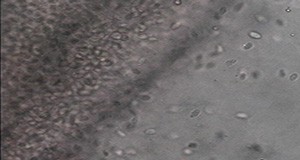
A group of species of single-celled parasites called Spironucleus cause disease in aquacultured and captive fish. Found in cold, temperate, and tropical climates, Spironucleus species can infect a variety of freshwater and marine ornamental and food fish, as well as crustaceans and shellfish.
Five species of Spironucleus are currently recognized: S. salmonicida, S. barkhaus, and S. torosa can infest marine organisms, while S. salmonis and S. vortens can infest freshwater ornamental fish. This four-page fact sheet written by Ruth Francis-Floyd and Roy P. E. Yanong and published by the Department of Large Animal Clinical Sciences focuses on S. vortens and its effects on ornamental cichlids, explaining which cichlids are susceptible, how to identify S. vortens , and how to confirm, manage, and prevent S. vortens infestations. (Photo credit: Roy P. E. Yanong, UF/IFAS Extension Tropical Aquaculture Laboratory)
http://edis.ifas.ufl.edu/vm053
Tag: Ruth Francis-Floyd
Carp Edema Virus Disease (CEVD) / Koi Sleepy Disease (KSD)
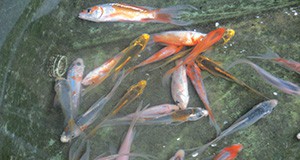
Carp edema virus disease is killing wild and cultured varieties of carp and worrying koi enthusiasts and carp aquaculturists in the United States and around the world. The disease causes skin lesions and swelling and is sometimes called “koi sleepy disease” because infected fish become lethargic and unresponsive. This 5-page fact sheet describes symptoms, diagnosis, prevention, and what fish producers, wholesalers, or retailers can do if they suspect carp may have contracted the disease. Written by Shohreh Hesami, Pedro Viadanna, Natalie Steckler. Staci Spears, Patrick Thompson, Karen Kelley, Roy Yanong, Ruth Francis-Floyd, Johnny Shelley, Joseph Groff, Andy Goodwin, Olga Haenen, and Thomas Waltzek, and published by the School of Forest Resources and Conservation Program in Fisheries and Aquatic Sciences.
http://edis.ifas.ufl.edu/fa189
Third Grade Manatee Curriculum
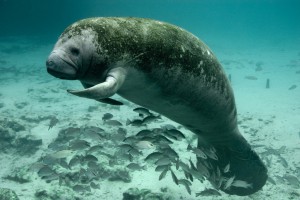
This 19 fact sheet curriculum series provides a series of individual lessons covering manatee biology and ecology, as well as highlighting some of the ways that humans impact and can protect manatees. The curriculum has been written at a third grade level but can be adapted for older or younger students. (Photo credit: Keith Ramos, USFWS)
http://edis.ifas.ufl.edu/topic_series_third_grade_manatee_workbook
Cryptobia iubilans in Cichlids
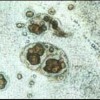 After many years of diagnostics at the University of Florida and at other laboratories around the country, it appears that Cryptobia iubilans is not uncommon among cichlids, and that environmental and other factors determine the extent of disease.This 3-page fact sheet was written by Ruth Francis-Floyd and Roy Yanong, and published by the UF Department of Fisheries and Aquatic Sciences, September 2014.
After many years of diagnostics at the University of Florida and at other laboratories around the country, it appears that Cryptobia iubilans is not uncommon among cichlids, and that environmental and other factors determine the extent of disease.This 3-page fact sheet was written by Ruth Francis-Floyd and Roy Yanong, and published by the UF Department of Fisheries and Aquatic Sciences, September 2014.
http://edis.ifas.ufl.edu/vm077
Koi Herpesvirus Disease (KHVD) (VM149/VM113)
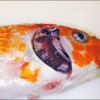 Koi herpesvirus (KHV) is a highly contagious virus that causes significant morbidity and mortality in common carp varieties. Common carp is raised as a foodfish in many countries and has also been selectively bred for the ornamental fish industry where it is known as koi. The first recognized case of KHV occurred in the United Kingdom in 1996. Since then other cases have been confirmed in almost all countries that culture koi and/or common carp with the exception of Australia. This 9-page fact sheet is intended to inform veterinarians, biologists, fish producers and hobbyists about KHV disease. Written by Kathleen H. Hartman, Roy P.E. Yanong, Deborah B. Pouder, B. Denise Petty, Ruth Francis-Floyd, Allen C. Riggs, and Thomas B. Waltzek, and published by the UF Department of Fisheries and Aquatic Sciences, April 2013.
Koi herpesvirus (KHV) is a highly contagious virus that causes significant morbidity and mortality in common carp varieties. Common carp is raised as a foodfish in many countries and has also been selectively bred for the ornamental fish industry where it is known as koi. The first recognized case of KHV occurred in the United Kingdom in 1996. Since then other cases have been confirmed in almost all countries that culture koi and/or common carp with the exception of Australia. This 9-page fact sheet is intended to inform veterinarians, biologists, fish producers and hobbyists about KHV disease. Written by Kathleen H. Hartman, Roy P.E. Yanong, Deborah B. Pouder, B. Denise Petty, Ruth Francis-Floyd, Allen C. Riggs, and Thomas B. Waltzek, and published by the UF Department of Fisheries and Aquatic Sciences, April 2013.
http://edis.ifas.ufl.edu/vm113
Spring Viremia of Carp (VM142/VM106)
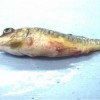 Spring viremia of carp is a viral disease that can cause significant mortality in several carp species including the common carp. It was reported in koi and feral carp in the United States for the first time in 2002. Diagnosis in farm raised fish in the U.S. may result in quarantine of the infected fish and depopulation. This 5-page fact sheet is intended to inform veterinarians, biologists, culturists, and hobbyists about Spring viremia of carp. Written by Barbara D. Petty, Ruth Francis-Floyd, and Roy P.E. Yanong, and published by the UF Department of Fisheries and Aquatic Sciences, August 2012.
Spring viremia of carp is a viral disease that can cause significant mortality in several carp species including the common carp. It was reported in koi and feral carp in the United States for the first time in 2002. Diagnosis in farm raised fish in the U.S. may result in quarantine of the infected fish and depopulation. This 5-page fact sheet is intended to inform veterinarians, biologists, culturists, and hobbyists about Spring viremia of carp. Written by Barbara D. Petty, Ruth Francis-Floyd, and Roy P.E. Yanong, and published by the UF Department of Fisheries and Aquatic Sciences, August 2012.
http://edis.ifas.ufl.edu/vm106
Common Monogenean Parasites of Fishes (FA28/FA033)
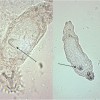 Monogeneans are a class of parasitic flatworms that are commonly found on fishes and lower aquatic invertebrates. Most monogeneans are browsers that move about freely on the fish’s body surface feeding on mucus and epithelial cells of the skin and gills; however, a few adult monogeneans will remain permanently attached to a single site on the host. Some monogenean species invade the rectal cavity, ureter, body cavity, and even the blood vascular system. Between 4,000 and 5,000 species of monogeneans have been described. They are found on fishes in fresh and salt water and in a wide range of water temperatures. This 10-page fact sheet was written by Peggy Reed, Ruth Francis-Floyd, and RuthEllen Klinger, and published by the UF Department of Fisheries and Aquatic Sciences, June 2012.
Monogeneans are a class of parasitic flatworms that are commonly found on fishes and lower aquatic invertebrates. Most monogeneans are browsers that move about freely on the fish’s body surface feeding on mucus and epithelial cells of the skin and gills; however, a few adult monogeneans will remain permanently attached to a single site on the host. Some monogenean species invade the rectal cavity, ureter, body cavity, and even the blood vascular system. Between 4,000 and 5,000 species of monogeneans have been described. They are found on fishes in fresh and salt water and in a wide range of water temperatures. This 10-page fact sheet was written by Peggy Reed, Ruth Francis-Floyd, and RuthEllen Klinger, and published by the UF Department of Fisheries and Aquatic Sciences, June 2012.
http://edis.ifas.ufl.edu/fa033
FA16/FA031 Ammonia in Aquatic Systems
Revised! FA-16, a 5-page illustrated fact sheet by Ruth Francis-Floyd, Craig Watson, Denise Petty, and Deborah B. Pouder, informs aquarists, aquaculturists, and hobbyists about this important water quality parameter, its affect on fish health, the nitrogen cycle that eliminates ammonia from water, how to test for ammonia, and how to manage an ammonia problem. Includes references. Published by the UF School of Forest Resources and Conservation, Program in Fisheries and Aquatic Sciences, February 2009.
http://edis.ifas.ufl.edu/FA031
VM-148/VM112 Response to a Suspected Toxin-Induced Fish Kill
Revised! VM-148, a 4-page illustrated fact sheet by Ruth Francis-Floyd, Christopher Brooks and Denise Petty, outlines the steps to take in response to any catastrophic fish kill, and it explains the special procedures to follow when a toxin is suspected of having caused the problem. Published by the UF College of Veterinary Medicine, November 2006.
http://edis.ifas.ufl.edu/VM112
VM-149/VM113 Koi Herpesvirus (KHV) Disease
Revised! VM-149, a 9-page illustrated fact sheet by Kathleen H. Hartman, Roy P.E. Yanong, Deborah B. Pouder, B. Denise Petty, Ruth Francis-Floyd and Allen C. Riggs, informs veterinarians, biologists, fish producers and hobbyists about the KHV disease in a question-and-answer format. Includes glossary and references. Published by the UF College of Veterinary Medicine, October 2008.
http://edis.ifas.ufl.edu/VM113